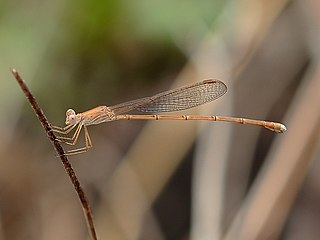
Rhadinosticta is a genus of damselfly in the family Isostictidae, endemic to eastern Australia. Species of Rhadinosticta are slender, medium-sized damselflies, with a dull colouring.

Austroargiolestes is a genus of damselflies in the family Argiolestidae. They are commonly known as Flatwings; unlike many other damselflies, at rest their wings are spread out flat.

Lestoidea is a genus of damselflies in the family Lestoideidae, commonly known as bluestreaks. Its species are endemic to north-east Queensland, Australia, where they inhabit rainforest streams.

Austroagrion is a genus of damselflies belonging to the family Coenagrionidae. Species of Austroagrion are small damselflies; males are black with blue or green markings while females are paler. Austroagrion occurs in Papua New Guinea, New Caledonia and Australia.

Austrocnemis is a genus of damselflies belonging to the family Coenagrionidae. Species of Austrocnemis are tiny, bronze-black damselflies with long legs. They occur in New Guinea and Australia.

Caliagrion is a monotypic genus of damselflies belonging to the family Coenagrionidae. The single species of this genus, Caliagrion billinghursti, is commonly known as a large riverdamsel, and is endemic to south-eastern Australia, where it inhabits slow-flowing rivers and ponds.

Austrosticta is a genus of damselflies belonging to the family Isostictidae. It is endemic to northern Australia. Species of Austrosticta are medium-sized damselflies, dull grey-brown in colour.

Oristicta is a genus of damselflies belonging to the family Isostictidae. It is endemic to north-eastern Australia. Species of Orosticta are slender, medium-sized damselflies with a dull colouring.

Griseargiolestes is a genus of damselflies in the family Megapodagrionidae. They are medium-sized, black and green metallic damselflies with pale markings, endemic to eastern Australia.

Agriocnemis rubricauda is a species of Australian damselfly in the family Coenagrionidae, commonly known as a red-rumped wisp. It is a small damselfly; the male has a red end to his tail. It has been recorded from northern Australia where it inhabits boggy seepages and swamps.

Archibasis mimetes is a species of damselfly in the family Coenagrionidae, commonly known as a blue-banded longtail. It is a medium-sized damselfly; the male is bright blue and black. It has been recorded from New Guinea and northern Australia, where it inhabits streams.

Coenagrion lyelli is a species of damselfly in the family Coenagrionidae, commonly known as a swamp bluet. It is a medium-sized damselfly, the male is bright blue with black markings. It is found in south-eastern Australia, where it inhabits streams, pools and lakes.

Neosticta canescens is a species of damselfly in the family Isostictidae, commonly known as a southern pinfly. It can be found in eastern Australia, where it inhabits streams.

Neosticta silvarum is a species of damselfly in the family Isostictidae, commonly known as a forest pinfly. It is endemic to tropical north-eastern Queensland, Australia, where it inhabits streams in rainforest.

Austrolestes insularis is an Australian species of damselfly in the family Lestidae, commonly known as a northern ringtail. It is widespread across northern Australia, where it inhabits streams, pools, and ponds.

Indolestes alleni is a species of damselfly in the family Lestidae, commonly known as a small reedling. It is found across northern Australia where it inhabits lagoons, ponds and swamps.

Lestoidea conjuncta is a species of Australian damselfly in the family Lestoideidae, known as a common bluestreak. It is endemic to coastal north-east Queensland, where it inhabits streams in rainforest.

Austroargiolestes alpinus is a species of Australian damselfly in the family Megapodagrionidae, commonly known as a New England flatwing. It is endemic to north-eastern New South Wales, where it inhabits streams and bogs.

Austroargiolestes chrysoides is a species of Australian damselfly in the family Megapodagrionidae, commonly known as a golden flatwing. It is endemic to south-eastern Queensland, where it inhabits streams in rainforest.

Episynlestes albicauda is a species of Australian damselfly in the family Synlestidae, commonly known as a southern whitetip. It is endemic to south-eastern Queensland and north-eastern New South Wales, where it inhabits streams and pools in rainforests.




















